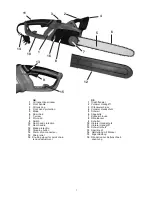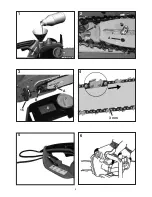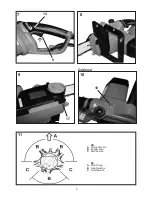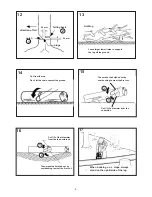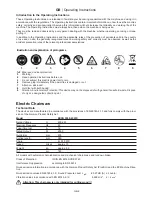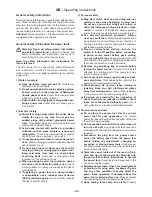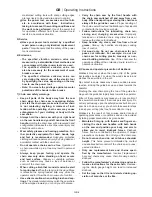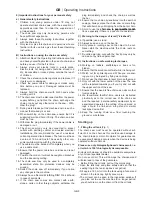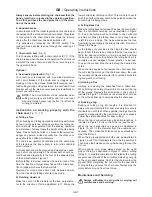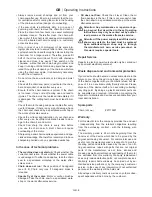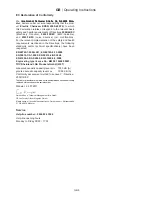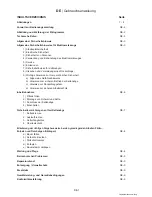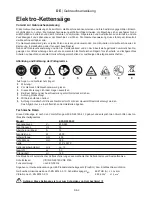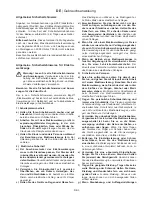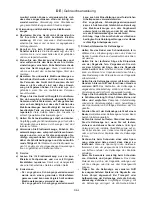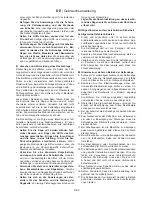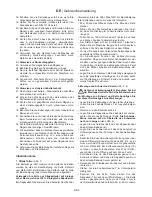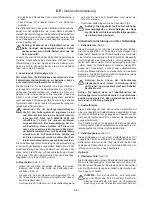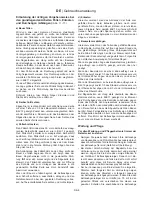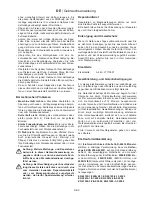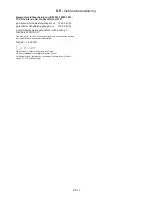
GB
|
Operating Instructions
GB-7
Always ensure before starting the chainsaw that the
hand protection 4 is locked in the operating position.
To do this, pull back the hand protection in the direc-
tion of the handle.
2. Rundown brake
In accordance with the latest regulations, this chain saw
is equipped with a mechanical rundown brake. This brake
is connected to the chain brake and stops the running
chain after the chain saw has been switched off.
It is activated by releasing the ON/OFF switch. The
rundown brake avoids injuries through the coasting of
the chain.
3. Chain catch bolt
(Fig. 9)
This chainsaw is fitted with a chain catch bolt (17). If the
chain breaks when the saw is in operation, the chain bolt
will catch the loose chain end and thus prevent injury to
the operator‘s hand.
Optional
4. Overloading protection
(Fig. 10)
Your chain saw is designed with a overload protection
with circuit breaker. If the chain saw is clogged (e.g.
blocking of the cutting blade, blade teeth jammed, over-
load cutting) during cutting operation, the overload circuit
breaker will cut the mains power supply automatically to
protect your chain saw.
NOTE:
The circuit breaker will be activated when
cutting current is over 35-40 A, and it can be reset
manually through press reset button (18) after 30s
cooling completely.
Instructions on working properly with the
chain saw
(Fig. 11 - 17)
a) Felling a Tree
When bucking and felling operations are being performed
by two or more persons, at the same time, the felling op-
eration should be separated from the bucking operation
by a distance of at least twice the height of the tree being
felled. Trees should be felled in a manner that would en-
danger any person, strike any utility line, the utility com-
pany should be notified immediately.
The chain saw operator should keep on the uphill side
of the terrain as the tree is likely to roll or slide downhill
after it is felled.
A retreat path should be planned and cleared as neces-
sary befor cuts are started. The retreat path should ex-
tend back and diagonally to the rear of the expected line
of fall as illustrated in Figure 11.
Before felling is started, consider the natural lean of the
tree, the location of larger branches and the wind direc-
tion to judge which way the tree will fall.
Remove dirt, stones, loose bark, nails, staples, and wire
from the tree where felling cuts are to be made.
b) Notching Undercut
Make the notch 1/3 the diameter of the tree, perpendicu-
lar to the direction of fall as illustrated in 11. Make the
lower horiziontal notching cut first. This will help to avoid
pinching of either the saw chain or the guide bar when the
second notch is being made.
c) Felling Back Cut
Make the felling back cut at least 2 inches (50 mm) higher
than the horizontal notching cut as illustrated in Figure
12. Keep the felling back cut parallel to the horizontal
notching cut. Make the felling back cut so enough wood
is left to act as a hinge. The hinge wood keeps the tree
from twisting and falling in the wrong direction. Do not cut
through the hinge.
As the felling cut gets close to the hinge the tree should
begin to fall. If there is any chance that the tree may not
fall in the desired direction or it may rock back and bind
the saw chain, stop cutting before the felling back cut is
complete and use wedges of wood, plastic or aluminum
to open the cut and drop the tree along the desired line
of fall.
When the tree begins to fall remove the chain saw from
the cut, stop the motor, put the chain saw down, then use
the retreat path planned. Be alert for overhead limbs fall-
ing and watch your footing.
d) Limbing a Tree
Limbing is removing the branches from a fallen tree.
When limbing, leave larger lower limbs to support the log
off the ground. Remove the small limbs in one cut as il-
lustrated in Figure 13. Branches under tension should be
cut from the bottom up to avoid binding the chain saw.
e) Bucking a Log
Bucking is cutting a log into lengths. It is important to
make sure your footing is firm and your weight is evenly
distributed on both feet. When possible, the log should be
raised and supported by the use of limbs, logs or chocks.
Follow the simple directions for easy cutting.
When the log is supported along its entire length as il-
lustrated in Figure 14, it is cut from the top (over-buck).
When the log is supported on one end, as illustrated in
Figure 15, cut 1/3 the diameter from the underside (un-
derbuck). Then make the finished cut by overbucking to
meet the first cut.
When the log is supported on both ends, as illustrated in
Figure 16, cut 1/3 of that diameter from the top overbruck.
Then make the finished cut by underbucking to meet the
first cut.
When bucking on a slope always stand on the uphill
side of the log, as illustrated in Figure 17. When “cutting
through”, to maintain complete control release the cutting
pressure near the end of the cut without relaxing your grip
on the chain saw handles. Don’t let the chain contact the
ground. After completing the cut, wait for the saw chain
to stop before you move the chain saw. Always stop the
motor before moving from tree to tree.
Maintenance and Servicing
Always withdraw the plug when carrying out
maintenance and servicing.


